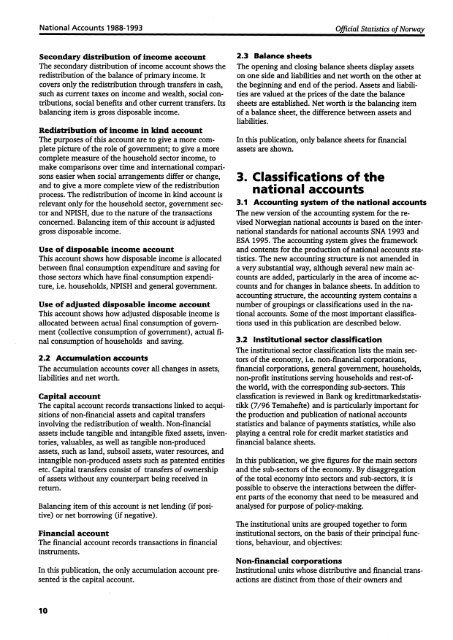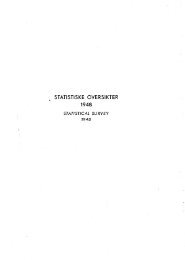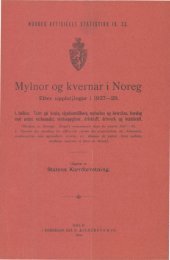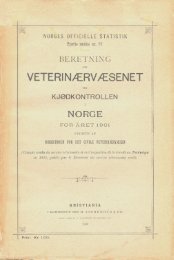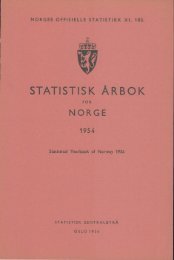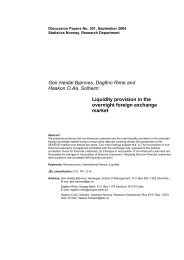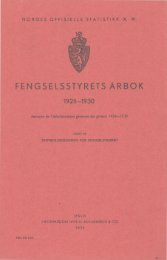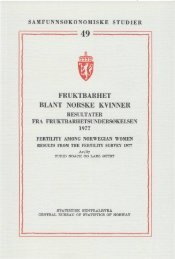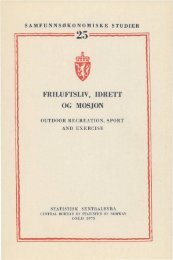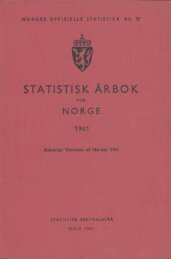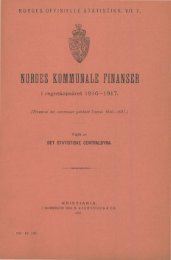National Accounts 1988-1993. Institutional Sector Accounts
National Accounts 1988-1993. Institutional Sector Accounts
National Accounts 1988-1993. Institutional Sector Accounts
Create successful ePaper yourself
Turn your PDF publications into a flip-book with our unique Google optimized e-Paper software.
<strong>National</strong> <strong>Accounts</strong> <strong>1988</strong>-1993<br />
Official Statistics of Norway<br />
Secondary distribution of income account<br />
The secondary distribution of income account shows the<br />
redistribution of the balance of primary income. It<br />
covers only the redistribution through transfers in cash,<br />
such as current taxes on income and wealth, social contributions,<br />
social benefits and other current transfers. Its<br />
balancing item is gross disposable income.<br />
Redistribution of income in kind account<br />
The purposes of this account are to give a more complete<br />
picture of the role of government; to give a more<br />
complete measure of the household sector income, to<br />
make comparisons over time and international comparisons<br />
easier when social arrangements differ or change,<br />
and to give a more complete view of the redistribution<br />
process. The redistribution of income in kind account is<br />
relevant only for the household sector, government sector<br />
and NPISH, due to the nature of the transactions<br />
concerned. Balancing item of this account is adjusted<br />
gross disposable income.<br />
Use of disposable income account<br />
This account shows how disposable income is allocated<br />
between final consumption expenditure and saving for<br />
those sectors which have final consumption expenditure,<br />
i.e. households, NPISH and general government.<br />
Use of adjusted disposable income account<br />
This account shows how adjusted disposable income is<br />
allocated between actual final consumption of government<br />
(collective consumption of government), actual final<br />
consumption of households and saving.<br />
2.2 Accumulation accounts<br />
The accumulation accounts cover all changes in assets,<br />
liabilities and net worth.<br />
Capital account<br />
The capital account records transactions linked to acquisitions<br />
of non-financial assets and capital transfers<br />
involving the redistribution of wealth. Non-financial<br />
assets include tangible and intangible fixed assets, inventories,<br />
valuables, as well as tangible non-produced<br />
assets, such as land, subsoil assets, water resources, and<br />
intangible non-produced assets such as patented entities<br />
etc. Capital transfers consist of transfers of ownership<br />
of assets without any counterpart being received in<br />
return.<br />
Balancing item of this account is net lending (if positive)<br />
or net borrowing (if negative).<br />
Financial account<br />
The financial account records transactions in financial<br />
instruments.<br />
In this publication, the only accumulation account presented<br />
is the capital account.<br />
2.3 Balance sheets<br />
The opening and closing balance sheets display assets<br />
on one side and liabilities and net worth on the other at<br />
the beginning and end of the period. Assets and liabilities<br />
are valued at the prices of the date the balance<br />
sheets are established. Net worth is the balancing item<br />
of a balance sheet, the difference between assets and<br />
liabilities.<br />
In this publication, only balance sheets for financial<br />
assets are shown.<br />
3. Classifications of the<br />
national accounts<br />
3.1 Accounting system of the national accounts<br />
The new version of the accounting system for the revised<br />
Norwegian national accounts is based on the international<br />
standards for national accounts SNA 1993 and<br />
ESA 1995. The accounting system gives the framework<br />
and contents for the production of national accounts statistics.<br />
The new accounting structure is not amended in<br />
a very substantial way, although several new main accounts<br />
are added, particularly in the area of income accounts<br />
and for changes in balance sheets. In addition to<br />
accounting structure, the accounting system contains a<br />
number of groupings or classifications used in the national<br />
accounts. Some of the most important classifications<br />
used in this publication are described below.<br />
3.2 <strong>Institutional</strong> sector classification<br />
The institutional sector classification lists the main sectors<br />
of the economy, i.e. non-financial corporations,<br />
financial corporations, general government, households,<br />
non-profit institutions serving households and rest-ofthe<br />
world, with the corresponding sub-sectors. This<br />
classfication is reviewed in Bank og kredittmarkedstatistikk<br />
(7/96 Temahefte) and is particularly important for<br />
the production and publication of national accounts<br />
statistics and balance of payments statistics, while also<br />
playing a central role for credit market statistics and<br />
financial balance sheets.<br />
In this publication, we give figures for the main sectors<br />
and the sub-sectors of the economy. By disaggregation<br />
of the total economy into sectors and sub-sectors, it is<br />
possible to observe the interactions between the different<br />
parts of the economy that need to be measured and<br />
analysed for purpose of policy-making.<br />
The institutional units are grouped together to form<br />
institutional sectors, on the basis of their principal functions,<br />
behaviour, and objectives:<br />
Non-financial corporations<br />
<strong>Institutional</strong> units whose distributive and financial transactions<br />
are distinct from those of their owners and<br />
10


